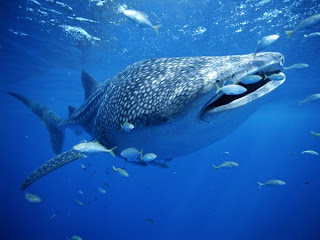Lately the local papers and even some TV stations have been documenting the seasonal migration of many types of whales off our shores. Close ups from whale watching boats as well as aerial shots show many types of whales and porpoises including the solitary journey of the massive blue whales and pods of pilot whales and killer whales. Unusually large amounts of plankton in our waters is said to account for the most sightings in many years. Those lucky enough to get a close look at one of God’s most magnificent creatures will treasure the memory.
I have one of those memories. Even though it is from many years ago it is as if I can click a “Play” button in my mind and watch a replay at any time with all the color and awe of the original happening. In my case it is not one of the various whales, but a whale shark, which most certainly qualifies as one of God’s most magnificent creatures as well.
Why it is called a whale shark I don’t know because it is not a whale. A whale is a mammal; the whale shark is a fish. Why it is called a shark I also don’t know because it in no way resembles a shark other than they both have a head and a tail. It especially does not resemble a shark in its desire to eat other fish and occasionally people. They are the exact opposite, kind of a fish version of Eeyore.
We were on a fishing boat some 10 miles off Bahia de los Frailes (Bay of the Friars), a small, protected bay just around the corner from Cabo San Lucas in the Bay of California. It was a hot spring day with not a breath of air. The ocean was as flat as a pool table for as far as we could see. When the ocean is that calm, anything that breaks the surface, no matter how big or small can be seen for miles. We were fishing for marlin and tuna so all eyes were scanning the ocean’s surface for birds, bait fish or other signs of life. Off in the distance we could see 2 forked tail, frigate birds slowly circling way up in the sky. Fishermen know to follow birds because their uncanny eye sight can find fish humans would meander right by. We headed in their direction.
As we got closer we could make out a dark object, just breaking the surface, moving very slowly in a large arc back and forth. The sun was in our eyes as we approached, preventing us from seeing down into the water. Moving as slow as we could so as not to spook whatever it was, we circled around so the sun would be at our back. As we did, we could now had nearly unlimited visibility into the purple blue water. What we saw left us speechless.Whale sharks can get up 50 feet long and weigh 20 tons. This one was right there. The dark object we had seen was the tip of the whale sharks tail. If you can picture a guppy with a big front end tapering back to a tiny tail and then multiply that by a bazillion, that’s what this fish looked like. He was brownish gray in color with yellow and white spots and stripes. While the tail was at the surface the massive, flat head was some 10 feet under water. His mouth, some 4 feet across, was open as he engulfed plankton by the ton.
It was as if he had his own village with him. A small school of 100 pound yellow fin tuna swam along in his shadow. Small schools of mackerel and sardines swam close to the big giant to protect themselves from larger predators. Remora clung to his body while other small fish were busy keeping him clean. We idled along next to him for close to an hour, his glacial pace never changing. Eventually he inched deeper and deeper until he disappeared from view. The last thing we saw was the tip of his tail in one last sweep.


A guppy times a bazillion. HAAAAHAHAHAHA! What a perfect description! I feel like I was right there on the boat with you… like seeing the gigantic guppy (guppy. hahahaha!) is one of my most treasured memories now too.
ReplyDeleteThank you!!